Elevated HuR in Pancreas Promotes a Pancreatitis-Like Inflammatory Microenvironment That Facilitates Tumor Development
- PMID: 29133460
- PMCID: PMC5770537
- DOI: 10.1128/MCB.00427-17
Elevated HuR in Pancreas Promotes a Pancreatitis-Like Inflammatory Microenvironment That Facilitates Tumor Development
Abstract
Human antigen R (ELAVL1; HuR) is perhaps the best-characterized RNA-binding protein. Through its overexpression in various tumor types, HuR promotes posttranscriptional regulation of target genes in multiple core signaling pathways associated with tumor progression. The role of HuR overexpression in pancreatic tumorigenesis is unknown and led us to explore the consequences of HuR overexpression using a novel transgenic mouse model that has a >2-fold elevation of pancreatic HuR expression. Histologically, HuR-overexpressing pancreas displays a fibroinflammatory response and other pathological features characteristic of chronic pancreatitis. This pathology is reflected in changes in the pancreatic gene expression profile due, in part, to genes whose expression changes as a consequence of direct binding of their respective mRNAs to HuR. Older mice develop pancreatic steatosis and severe glucose intolerance. Elevated HuR cooperated with mutant K-rasG12D to result in a 3.4-fold increase in pancreatic ductal adenocarcinoma (PDAC) incidence compared to PDAC presence in K-rasG12D alone. These findings implicate HuR as a facilitator of pancreatic tumorigenesis, especially in the setting of inflammation, and a novel therapeutic target for pancreatitis treatment.
Keywords: HuR; cancer; inflammation; pancreas.
Copyright © 2018 American Society for Microbiology.
Figures




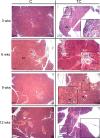



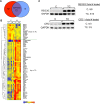

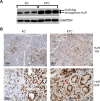
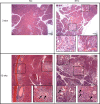
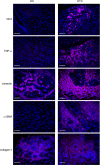



Similar articles
-
Human antigen R mediated post-transcriptional regulation of inhibitors of apoptosis proteins in pancreatic cancer.World J Gastroenterol. 2019 Jan 14;25(2):205-219. doi: 10.3748/wjg.v25.i2.205. World J Gastroenterol. 2019. PMID: 30670910 Free PMC article.
-
Targeting the mRNA-binding protein HuR impairs malignant characteristics of pancreatic ductal adenocarcinoma cells.Oncotarget. 2015 Sep 29;6(29):27312-31. doi: 10.18632/oncotarget.4743. Oncotarget. 2015. PMID: 26314962 Free PMC article.
-
Posttranscriptional Regulation of PARG mRNA by HuR Facilitates DNA Repair and Resistance to PARP Inhibitors.Cancer Res. 2017 Sep 15;77(18):5011-5025. doi: 10.1158/0008-5472.CAN-16-2704. Epub 2017 Jul 7. Cancer Res. 2017. PMID: 28687616 Free PMC article.
-
Understanding and targeting the disease-related RNA binding protein human antigen R (HuR).Wiley Interdiscip Rev RNA. 2020 May;11(3):e1581. doi: 10.1002/wrna.1581. Epub 2020 Jan 23. Wiley Interdiscip Rev RNA. 2020. PMID: 31970930 Free PMC article. Review.
-
Complex HuR function in pancreatic cancer cells.Wiley Interdiscip Rev RNA. 2018 May;9(3):e1469. doi: 10.1002/wrna.1469. Epub 2018 Feb 16. Wiley Interdiscip Rev RNA. 2018. PMID: 29452455 Free PMC article. Review.
Cited by
-
The RNA-Binding Protein HuR in Digestive System Tumors.Biomed Res Int. 2020 Jul 24;2020:9656051. doi: 10.1155/2020/9656051. eCollection 2020. Biomed Res Int. 2020. PMID: 32775456 Free PMC article. Review.
-
MYB sustains hypoxic survival of pancreatic cancer cells by facilitating metabolic reprogramming.EMBO Rep. 2023 Mar 6;24(3):e55643. doi: 10.15252/embr.202255643. Epub 2023 Jan 2. EMBO Rep. 2023. PMID: 36592158 Free PMC article.
-
RNA-Binding Proteins as Important Regulators of Long Non-Coding RNAs in Cancer.Int J Mol Sci. 2020 Apr 23;21(8):2969. doi: 10.3390/ijms21082969. Int J Mol Sci. 2020. PMID: 32340118 Free PMC article. Review.
-
CircRNAs expression profile and potential roles of circRERE-PMN in pre-metastatic lungs.Front Immunol. 2024 Aug 26;15:1455603. doi: 10.3389/fimmu.2024.1455603. eCollection 2024. Front Immunol. 2024. PMID: 39253079 Free PMC article.
-
RNA-Binding Proteins as Regulators of Migration, Invasion and Metastasis in Oral Squamous Cell Carcinoma.Int J Mol Sci. 2020 Sep 17;21(18):6835. doi: 10.3390/ijms21186835. Int J Mol Sci. 2020. PMID: 32957697 Free PMC article. Review.
References
-
- Blanco FF, Jimbo M, Wulfkuhle J, Gallagher I, Deng J, Enyenihi L, Meisner-Kober N, Londin ER, Rigoutsos I, Sawicki JA, Risud MV, Witkiewicz AK, McCue PA, Jiang W, Rui H, Yeo CJ, Petricoin EF, Winter JM, Brody JR. 2016. The mRNA-binding protein HuR promotes hypoxia-induced chemoresistance through posttranscriptional regulation of the proto-oncogene PIM1 in pancreatic cancer cells. Oncogene 35:2529–2541. doi:10.1038/onc.2015.325. - DOI - PMC - PubMed
-
- Costantino CL, Witkiewicz AK, Kuwano Y, Cozzitorto JA, Kennedy EP, Dasgupta A, Keen JC, Yeo CJ, Gorospe M, Brody JR. 2009. The role of HuR in gemcitabine efficacy in pancreatic cancer: HuR up-regulates the expression of the gemcitabine metabolizing enzyme deoxycytidine kinase. Cancer Res 69:4567–4572. doi:10.1158/0008-5472.CAN-09-0371. - DOI - PMC - PubMed
-
- Lal S, Burkhart RA, Bhattacharjee V, Beeharry N, Londin ER, Cozzitorto JA, Romeo C, Jimbo M, Norris ZA, Yeo CJ, Sawicki JA, Winter JM, Rigoutsos I, Yen TJ, Brody JR. 2014. HuR post-transcriptionally regulates WEE1: implications for the DNA damage response in pancreatic cancer cells. Cancer Res 74:1128–1140. doi:10.1158/0008-5472.CAN-13-1915. - DOI - PMC - PubMed
-
- McAllister F, Pineda DM, Jimbo M, Lal S, Burkhart RA, Moughan J, Winter KA, Abdelmohsen K, Gorospe M, Acosta AdJ, Lankapalli RH, Winter JM, Yeo CJ, Witkiewicz AK, Iacobuzio-Donahue CA, Laheru D, Brody JR. 2014. dCK expression correlates with 5-fluorouracil efficacy and HuR cytoplasmic expression in pancreatic cancer. Cancer Biol Ther 15:688–698. doi:10.4161/cbt.28413. - DOI - PMC - PubMed
Publication types
MeSH terms
Substances
Grants and funding
LinkOut - more resources
Full Text Sources
Other Literature Sources
Medical
Molecular Biology Databases
Miscellaneous
